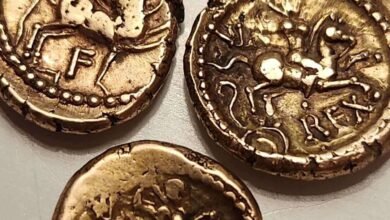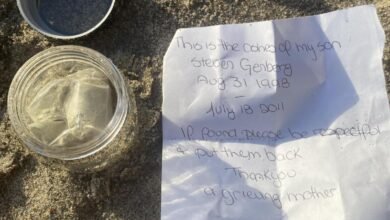Lucky treasure hunter wins metal detector in raffle

- Mickey Richardson found over 200 silver coins in a muddy field in Ansty, Dorset
A lucky treasure hunter has discovered a hoard of silver coins worth £23,000 using a metal detector he won in a raffle.
Novice Mickey Richardson had only been using the metal detector for three months when he made the discovery of a lifetime in a muddy field in Ansty, near Dorchester in Dorset.
After discovering the treasures, Mr Richardson spent a weekend digging up the 234 coins.
He said: “I only started the hobby a few months ago and had a very basic metal detector that I only took to Bournemouth beach.”
“But then I entered a metal detector club raffle in a Facebook group and won first prize, a top-of-the-range detector.”
“The weekend I found the treasure, I was just about to finish work when I received a strong signal and found a Charles I shilling. Then I searched the area again and received another signal, and then another signal, and another.
“I just couldn’t believe it. I dug up 74 silver coins the first day and was devastated afterward. I went back the next morning and thought it would be nice to round up to 100, but found a total of 234 coins spread out over a radius.”
The 63-year-old handed the coins over to his local lost property officer, as required by the Treasury Act.
The British Museum examined them for some time before declaring them invalid and returning them to Mr Richardson on the grounds that the finder should keep them.
He watched live as the coins were sold at the London auction house Spink & Son for £18,500. Including fees, the total price was £23,000.
Gregory Edmund of Spink said: “The seller streamed the sale live and was jumping for joy at some of the prices achieved. He was very happy.”
The grandfather, from Bournemouth in Dorset, has to split the proceeds 50/50 with the landowner, but is planning to use his share to buy a summer holiday for himself and his wife Rosalynd.
He said: “It was a day I will never forget. I alerted the Lost and Found officer and the rest is history.”
Mr Richardson said he had expected the treasure to sell for £10,000 at auction and was therefore very pleased with the final result.
It is believed that the coins were buried for safekeeping by a farmer in 1644 while the English Civil War was raging around him.
The owner never returned to collect his savings and was probably killed in the conflict. Over the next four centuries, the coins were repeatedly struck by a farmer’s plough and scattered across a vast field.
The coins cover the reigns of King Edward VI in the 1550s, Queen Elizabeth I, James I and Charles I. Some of the Elizabeth and James coins had been defaced by scratches, probably by a former Catholic owner in protest against their Protestant views and the Reformation of the Catholic Church.
Spink coin specialist Ella Mackenzie added: “This ensemble encompasses the most unstable period in our nation’s history.”
“These coins circulated in the pockets of a crucial period for England in many respects: constitutionally, religiously, socio-economically and, of course, politically.
“It was a rare privilege to be able to manage this treasure.”
Britain has a long history of Civil War hoards, with nearly 400 cases documented across the country.
However, auctioneers said it was still rare for them to be auctioned publicly.



